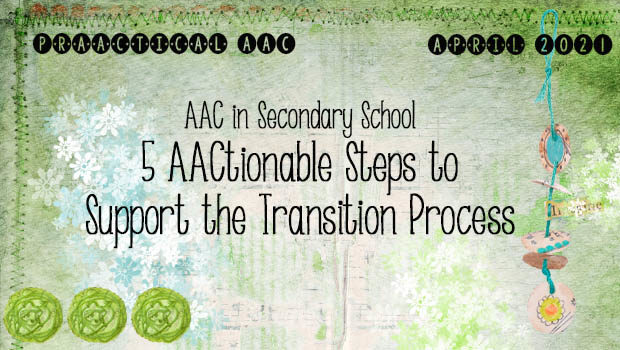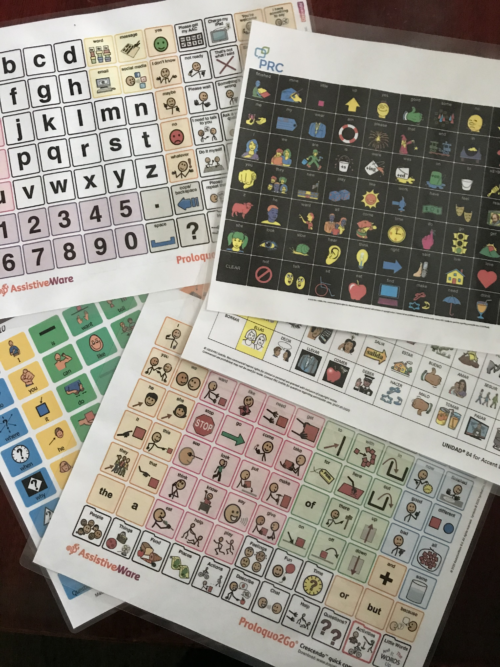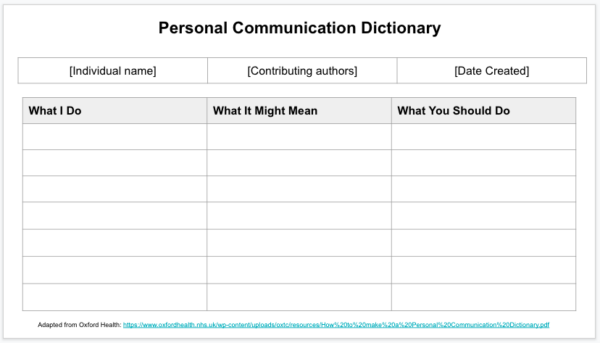AAC in Secondary School: 5 AACtionable Steps to Support the Transition Process

We’re back with another post in our series focusing on supporting students to use AAC during their high school years. AAC SLP Ashley Larisey, an SLP at Community High School District 218 in Oak Lawn, Illinois, is here to discuss ways to support students who use AAC as they prepare to transition out of school. Ashley, who is also an Adjunct Clinical Supervisor and Instructor at Saint Xavier University, has some prAACtical suggestions that will be of interest to SLPs, OTs, teachers, and parents alike.
Enjoy!
5 AACtionable Steps to Support the Transition Process
Do you have a student on your caseload who uses AAC and will be aging out of special education services soon? This can be an incredibly exciting time, but it can also be full of feelings of uncertainty. Hopefully, we have put in a lot of time and effort into supporting AAC users, their families, and communication partners throughout high school and post-secondary educational programming. This includes things like parent coaching and communication partner training, consultation, explicit instruction, and embedding language and communication into daily routines and naturally occurring environments. When the time comes that students are nearing transition, there are some actionable steps that we can take to support AAC users and their families to ensure that the transition goes as seamlessly as possible.
- Provide Troubleshooting Resources: If something malfunctions with the device, does the AAC user and their family know how to troubleshoot? Screens crack, batteries malfunction, icons get shuffled around or don’t function as they should – things happen! It isn’t always required or even necessary to go over every single thing that could go wrong, but it is important that AAC users and/or their caregivers know where to go when something isn’t working. Here are some suggestions to review.
-
- Technical Support: Thankfully in this day and age, there are many ways to get the support needed to troubleshoot technical issues! This might be a phone number, e-mail, or social media resource for specific systems.
- Local representative/consultant: Give families the direct contact information for their local representative if they need support with a technical issue. Representatives are knowledgeable about directing issues to the right person for help.
- Simple Programming: AAC users and their caregivers should be familiar with how to do some of the more frequently used functions within an AAC system like editing and backing up vocabulary files. Many companies have quick handouts for some of these more common functions within an AAC system that can be provided as a review prior to transition.
- Evaluation resources: We all know there are times when a system is in need of total replacement. Providing AAC users and their families with the resources to seek out an AAC evaluation and trial if needed is an important component of the transition process. We all know systems don’t last forever (far from it!) – there WILL be a time that the system no longer serves the user. Something as simple as a form with a list of potential sites to receive an AAC evaluation can be incredibly useful.
- Ensure there is a backup system in place: When something does go awry, making sure that a backup system is available for AAC users is always important, but even more so during the transition process. Some students might use an old dedicated system or app as a backup system, but this might not be an option for everyone. A low-tech backup for all AAC users helps to support all learners in the event that their main AAC system is broken or if they are in an environment where a high-tech system is not available. One quick and easy way to create a backup system is to take screenshots of the main AAC system and assemble those into a low-tech communication book or binder. Be sure to include a page with access to the alphabet – this will help ensure that AAC users can communicate a word that is not within the low-tech backup. Here are some links to pre-made low-tech AAC supports that can be used to create backup systems.
-
- Manual Communication Boards for Unity, LAMP, UNIDAD, CoreScanner, Essence, and PRC Wordpower
- Flipbooks and Manual Communication boards for Saltillo Wordpower (42 Basic, 60, 60 Basic, 108, and Wordpower48 Español Básico
- Directions for creating a core flipbook in Coughdrop
- Tobii Dynavox Printable Core First Communication Boards
- Project Core 36 Location Universal Core Communication Board
- Quick Communication Boards Proloquo2Go
- Grid 3 Manual Communication Boards
- Avaz AAC low tech core boards
- Speak for Yourself manual boards (Smarty Symbols)

Examples of various low-tech communication boards
- Create Communication Dictionaries: How can we relate some of the knowledge that we have obtained about the meaning of some of our students’ gestures, vocalizations, and facial expressions? A communication dictionary is an excellent tool to help teach people who are just meeting an individual who uses AAC more about how to be a good communication partner. A communication dictionary provides a guide that outlines what someone does, what we think it means, and what a good communication partner can do to respond. Check out these resources to see examples of communication dictionaries and to learn more:

- Explore communication opportunities within the new natural environment: Students are generally in school for 6-7 hours per day. There will be a new natural environment for that time frame post-transition. Where will the AAC user be during the time that they were typically at school? Will they be at work, college, a day program, at home, in the community, or volunteering? Trying to get the best picture of what the new natural environment will look like can go a long way towards identifying what communication opportunities will be available, and how we can model and support further language development within these new settings.
Educational teams can use tools to help AAC users plan for the future as part of the transition planning process. The Framing a Future Tool (King, Lunger, & Toomey – The Bridge School ©2005) is one example of a survey that can be used to develop person-centered goals. The survey is framed around seven major life areas (Community Membership, Control of Personal Health & Welfare, Pursuit of Lifelong Learning, Developing Talents & Interests, Creating Healthy Relationships, Self-Reliance, & Developing a Personal Sense of Spirituality) that are reviewed across four different stages. Determining what this new environment will look like based on what is important to the AAC user is just one piece of supporting a successful transition focused on self-determination.

Sample page from Framing a Future Tool (King, Lunger, Toomey)– The Bridge School ©2005

Sample page from Framing a Future Tool (King, Lunger, Toomey)– The Bridge School ©2005
- Provide pre-transition support within the new setting: If possible, provide support within the new environment prior to the transition. If the AAC user is working in a setting that will remain consistent post-transition, communication partner training with the new people in the individual’s life can be beneficial. Demonstrating respectful interactions by highlighting good communication partner strategies, acknowledging all communicative attempts, attributing meaning to non-symbolic means of communication, and providing aided language stimulation are all valuable ways to support both the AAC user and those new to them.
Communication Passports (CALL Scotland) are another great resource that can be co-constructed with the AAC user prior to transition. A Communication Passport provides information that is important to the AAC user and is created with person-centered planning in mind. It is important that they are created with permission and that the AAC user is an active participant in the composition of the passport. There are links to sample communication passports as well as a wealth of information that is important to consider prior to creating them here.
What AACtionable ways have you supported AAC users during the transition process? What strategies and supports would you add to this list?
::::::::::::::::::::::::::::::::::::::::::::::::::::::::::::::::::::::::::::::::::::::::::::::
You can see the previous posts in the series below.
Filed under: Featured Posts, PrAACtical Thinking
This post was written by Carole Zangari
